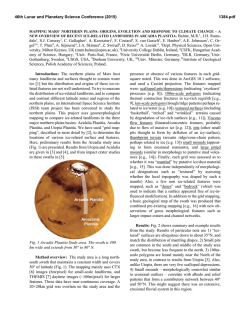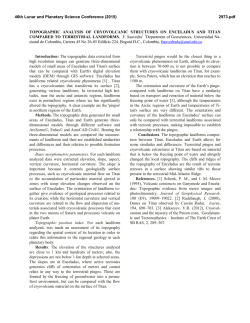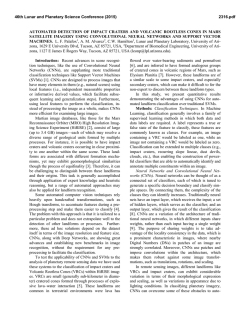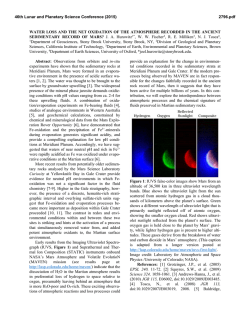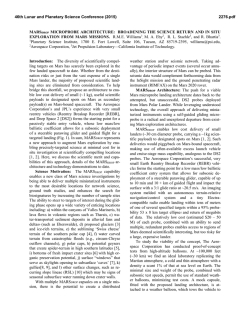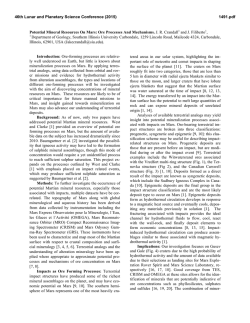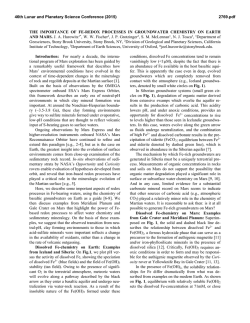
ORIGINS, EVOLUTION AND RESPONSE TO CLIMATE CHANGE
46th Lunar and Planetary Science Conference (2015) 1339.pdf MAPPING MARS’ NORTHERN PLAINS: ORIGINS, EVOLUTION AND RESPONSE TO CLIMATE CHANGE - AN OVERVIEW OF THE GRID MAPPING METHOD. Ramsdale, J.D.1, Balme, M.R.1,2, Conway, S.J., Costard, F., Gallagher, C., van Gasselt, S., Hauber, E., Johnsson, A.E., Kereszturi, A., Platz, T., Séjourné, A., Skinner, J.A., Jr., Reiss, D., Swirad, Z., Orgel, C., Losiak, A. 1Dept. Physical Sciences, Open University, Walton Hall, Milton Keynes, MK7 6AA ([email protected]). 2Planetary Science Institute, Suite 106, 1700 East Fort Lowell, Tuscon, AZ, USA. Introduction: An International Space Science Institute (ISSI) team project has been convened to study the northern plains of Mars. It uses geomorphological mapping to compare ice-related landforms in the three northern plains basins: Acidalia Planitia, Arcadia Planitia, and Utopia Planitia. The main science questions this project aims to answer are: 1) “What is the distribution of ice-related landforms in the northern plains, and can it be related to distinct latitude bands or different geological or geomorphological units?” 2) “What is the relationship between the latitude dependent mantle (LDM) and (i) landforms indicative of ground ice, and (ii) other geological units in the northern plains?” 3) “What are the distributions and associations of recent landforms indicative of thaw of ice or snow?” With increasing coverage of high-resolution images of the surface of Mars (e.g. Context Imager – CTX, ~ 6 m/pixel, covering ~ 90% of the surface as of December 2014 [1]) we are able to identify increasing numbers and varieties of small-scale landforms. Many such landforms are too small to represent on regional maps, yet determining their presence or absence across large areas can form the observational basis for developing hypotheses on the nature and history of an area. The combination of improved spatial resolution with nearcontinuous coverage increases the time required to analyse the data. This becomes problematic when attempting regional or global-scale studies of metrescale landforms. Here, we describe an approach for mapping small features across large areas that was formulated for the ISSI project. Results from this study are presented in [2,3,4]. Three study areas, each consisting of a long latitudinal swath, were defined in the Acidalia, Arcadia, and Utopia regions. Preliminary work established that traditional mapping, or survey techniques would not work: many of the landforms of interest (e.g., scalloped pits and 100m-scale polygonal fractures), could only be identified in CTX images viewed at 1:10,000 or 1:20,000 scale. However, to meet the project goals, we needed to map the distribution of such landforms across very large continuous areas. Identifying and recording landforms individually would take an impossibly long time, so an alternative approach was designed, described here. Method: Rather than traditional mapping with points, lines and polygons, we used a grid “tick box” approach to determine where specific landforms are. The mapping strips were divided into 90 ‘large’ grid squares, each approximately 100×100 km in extent. Each large grid was then subdivided into 25 “subgrids”. This created a 15×150 grid of squares, each approximately 20×20 km, for each study area. In ArcGIS, we produced a polygon shapefile in which each sub-grid was represented by a single square polygon. In the attribute table of this shapefile, a new attribute for each landform/surface type was added. CTX and THEMIS daytime images were then viewed systematically for each sub-grid square and the presence or absence of each of the basic suite of landforms recorded. The landforms are shown in Fig. 1. The landforms were recorded as “present”, “dominant”, or “absent” in each sub-grid square. Where relevant, each square was also recorded as “null” (meaning “no data”) or “possible” if there was uncertainty in identification (but where the mapper felt that there was some evidence to suggest that the landform was present). The result is a series of coarseresolution “rasters” showing the distribution of the different types of landforms across the strip (Fig. 1). Projection and data: The Arcadia study area, shown here as an example of what can be achieved with this approach, is a 300 km wide strip that extends over 50° latitude, centred on 170° W. We used a Cassini projection centred on the 170° west meridian. Analysis was performed primarily using publically available CTX images, downloaded pre-processed from the Arizona State University Mars Portal and inserted into ArcGIS. MOLA (Mars Orbiter Laser Altimeter [5]) gridded data and hillshade products and THEMIS (THermal EMission Imaging System [6]) images were downloaded from the Planetary Data 46th Lunar and Planetary Science Conference (2015) 1339.pdf Systems’ Geosciences Node, Mars Orbital Data Explorer (ODE) and used as basemaps. Assessment of the method: Grid mapping (Fig. 1; Table 1) is efficient: for each sub-grid, only the presence or absence of a landform needs to be ascertained, and no detailed digitising is needed. This also removes subjectivity: removing an individual’s decision as to where to draw boundaries and improving repeatability. If further resolution was needed, finerscale grids could be added. Carrying the null and zero values forward from the larger grids would mean only areas with positive values for that landform would need to be examined to increase the resolution for the whole strip. Pros Rapidly, ensures all areas are covered, actively marking negative results. At full CTX resolution. Cons If a landform needs to be added later, it would require going back over the whole dataset. Reproducible and scalable with group efforts. Transitions between colleagues are easier than traditional mapping as there are no lines or units to match up. Allows large datasets to be published in a series of smaller maps. Hard to discriminate between a single landform in a sub-grid, and many landforms covering perhaps 25% of the sub-grid. Tedious to implement, and doesn’t give a feel for the study area in the same way that mapping does. Comparable data for several strips across an area. Several landforms can be mapped at once. Only basic mapping and GIS skills needed. Table 1. Pros and Cons of the grid mapping method. Conclusion: Grid mapping provides an efficient and scalable approach to collecting data on large quantities of small landforms over large areas. Acknowledgements: This work was supported by the International Space Science Institute, Switzerland. References: [1] Malin, M. C. et al. (2007) JGR 112, doi: 10.1029/2006JE002808. [2], Balme, M.R., et al. (2015) LPSC XLVI, Abstr. #1339 [3], Hauber et al., (2015) LPSC XLVI, Abstr. #1359 [4] Séjourné et al., (2015) LPSC XLVI, Abstr. #1328, [5] Smith, D. E. et al. (2001) JGR 106, doi: 10.1029/2000JE001364. [6] Christensen, P. R. et al. (2004) Space Sci. Rev. 110, 85–130. [7] Tanaka, K. L., et al., (2005) Geologic map of the northern plains of Mars. Fig. 1 Arcadia Planitia results. a) Geological Map [7]. b) Summary of geomorphological grid mapping results. c) Grid mapping showing only the spatial density of “textured” (ice-degradation) landforms.
© Copyright 2025
